
“It’s supposed to be hard. If it wasn’t hard, everyone would do it. The hard is what makes it great.”
–Tom Hanks From A League of Their Own
Though there are a few select people who feel proud to be fat, most of us would like to be in better shape. The good news is every one of us can be, the bad news (for some people) is that is requires hard work. Most people spend more time making rationalizations and looking for excuses than they spend looking for solutions. The most common bullshit I hear from people about why they aren’t training is that they are too busy or they don’t want to pay to use a gym. I can relate to both of these concerns. After all, I’m a pretty busy guy myself and I think gym memberships are usually a rip-off too. Besides, why pay for a gym when you can get fit anywhere?
Any red-blooded man who’s walked beneath scaffolding has no doubt been tempted to jump up, grab on and go for it. Those bars are practically begging to be swung around on, hung from or climbed. One of the only things I dislike about my life in NYC is all the construction, but every cloud has a sliver lining. While it can be an eye sore, construction scaffolding is great for doing pull-ups.

Why pay for a gym when you can get fit anywhere?
When looking for places to train, your only limit is your creativity. Any overhead object that’s sturdy enough to support your weight is potentially suitable for pull-ups. Dips can be done in many out-of-the-box scenarios as well. Training on odd objects can sometimes offer unique challenges and benefits. The pull-up shown above offers a unique grip challenge.
While structured workout protocols can be very effective for those who stick to them consistently, you can actually get a lot done without specifically dedicating much extra time (or thought) to your workout. For example, say you pass under a scaffold every morning on your way to work or school, what’s to stop you from jumping up and doing just one set on the way there and one set on the way home? This would add less than a minute to your commute each way.
Now suppose you could find a place to do some dips during your day-to-day activities and fit a set or two of those in each day. A little bit here and there can add up over time and in a few weeks you would find yourself getting stronger. This technique of “greasing the groove” can be a very effective way to train (more on this in a bit).
I’m sure you can think of plenty of reasons not to train this way. You might feel silly or you might break a sweat in your nice shirt, but guess what? You might actually have some fun!
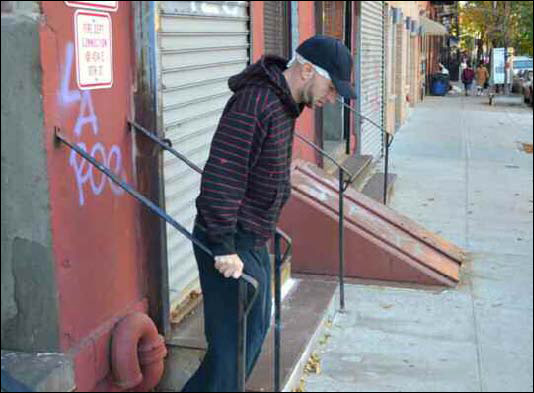
Get those reps in wherever you can!
I want to be perfectly clear that you don’t need to do anything more than basic exercises like pull-ups, dips and leg raises to build a strong, muscular upper body. Adding more complicated moves can make your training more interesting, but it won’t make you stronger than just training the basics. The world of freestyle calisthenics takes body-weight training out of the realm of exercise and into the performance arena. A lot of the moves I’ve discussed in this book are as much for showmanship as they are for a workout. Things like muscle-overs won’t necessarily make you stronger than regular muscle-ups. However, sometimes focusing on exercise as skill practice can be a great way to divert your focus from the physical rigors of strength training.
With that said, let me restate the first part of that thought: you can get very strong and muscular by just training pull-ups, dips and leg raises. You do not need to train any other movements unless you want to. Don’t forget what I said in Chapter One about strength in numbers. Get your reps up on those basic exercises and the strength will be there for the harder ones. Remember as well, that the risk for injury can be higher with some of the more advanced moves and freestyle exercises. Try them at your own risk!
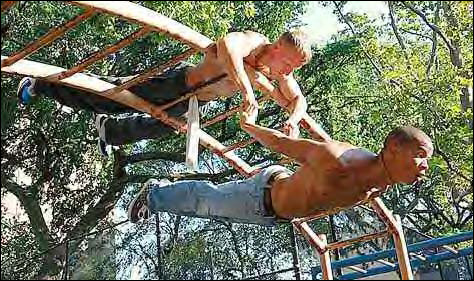
The world of freestyle calisthenics takes bodyweight training out of the realm of exercise and into the performance arena.
One of the most common questions I get asked is, “can I train calisthenics every day?” The answer is either a “yes” with a “but...” or a “no” followed by an “if...” It’s definitely not the same for everyone, but here goes!
Your muscles need rest in order to recover between workouts, but that amount of rest depends on three key factors: frequency, volume and individual conditioning.
Frequency refers to how often you train, volume is how much you do in a given workout and individual conditioning just means how good your individual body is at recovery. That last one comes from a combination of both training and genetic factors. While individual conditioning can be improved dramatically by implementing a fitness regimen, some people are just naturally better at recovery than others. Regardless, people who are training every day need to build to that gradually. Frequency and volume are the two factors you have the most direct control over, but you’ll need to experiment to find what works best for you (and is most realistic for your schedule).
Some people (like myself) get great results from exercising every day, while others who feel pressed for time can still make good gains training just three days a week. While I like to exercise daily, I can’t go all-out every time or I’ll run myself into the ground very quickly. The ratio between frequency and volume is the key to determine how much rest one needs between workouts. As one goes up, the other must go down.
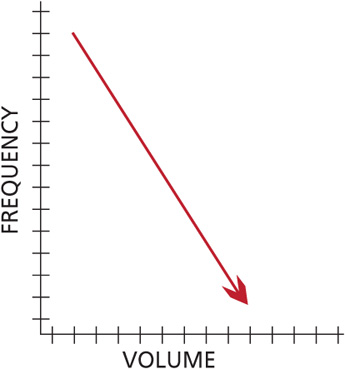
The term “greasing the groove,” coined by Pavel Tsatsouline, involves doing just a few reps at a time throughout the day, never working to total fatigue, like the scenario I presented to you before about doing a few scaffold pull-ups on your way around town. A couple reps here and there can add up with this method and great results can be achieved. This is one end of the frequency vs. volume spectrum.
Another underground strength training technique that has been around for a long time and has given many people great results is what’s called “German volume training.” This method is common in bodybuilding and power-lifting circles. It involves doing many sets of one exercise in one single session. A German volume workout might consist of 100 total reps of a difficult exercise spread out over ten or more consecutive sets, with only a minute or two between each set (who’s in for 100 pull-ups?). This type of workout will generally require lots of recovery time as it is extremely taxing on the body. Whereas greasing the groove may help you get strong without ever feeling very sore, German volume training can leave you sore for several days following a workout. Both techniques can be effective, however. There is not always one best method, you just need to make sure you have the right ratio.
Some people tend to equate muscle soreness with a good workout, and while that can sometimes be the case, it is not always so. I’ve had some groundbreaking workouts that left me with minimal soreness and I have had other workouts that left me sore for days even though they didn’t do much to improve my fitness. When I ran the NYC Marathon in 2009, my legs were sore as shit for two or three days, but that doesn’t mean I should be running a Marathon every time I work out!
As far as I can tell, the only thing that severe muscle soreness reflects is that I did something different than what my body is accustomed (perhaps more volume of the usual exercises or maybe a different modality altogether). For an amateur, this is a good thing. After all, what their body is used to is a whole lotta nothin’. But for someone with a solid training base, being excessively sore may actually prevent you from progressing. Beyond the first few weeks of beginning or restarting a training program, don’t put too much stock into whether or not you feel sore.
When I ran the NYC Marathon in 2009, my legs were sore as shit for two or three days, but that doesn’t mean I should be running a Marathon every time I work out!
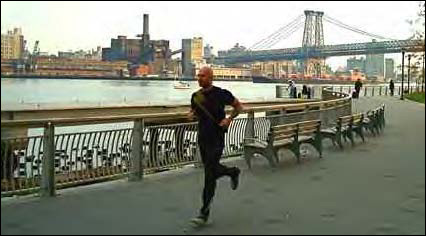
The number one reason why people don’t make progress in their training is a lack of consistency. They train hard for a week or two, then “life gets in the way” and they miss a week or two. This constant one step forward, one step backward approach leaves them standing in the same place year after year.
No matter what type of workout program you choose, you will never get anywhere without consistency. Three times a week is generally the minimum you can train and expect results, but the more often you work out, the better your results are likely to be. Just remember to keep that balance between frequency and volume. Splitting up your training so that you are working on different things on different days is a great way to train without burning yourself out. The most common way to accomplish this is to do all your pulling exercises on one day and all of your pushing exercises on a different day. Like I said in the beginning, you should probably have at least one day for legs in the mix too.

The number two reason people fail to progress is a lack of intensity. You absolutely must be able to push yourself through physical discomfort if you want to build strength and muscle. The funny thing is, your body doesn’t really understand the concept of a formal workout. Because of this, it starts telling your brain to stop long before you actually have done enough to affect change in your muscles. The human body hasn’t changed much since primitive times, though our lives today are very different. In nature, man needed to conserve his energy. He didn’t know when the next meal was coming or what he might have to do to get it. We don’t have these concerns in modern society so we can lay it all on the line for our workouts without worrying. Problem is, your mind is still programmed to want to stop as soon as a little fatigue sets in, so you have to be ready for that and prepare yourself to push through. You have to be smarter than your primitive mind.
While the idea of a caveman doing pull-ups seems silly, he may very well have needed to climb a tree to get some berries or to harvest some honey (climbing and pull-ups go hand in hand, by the way). Now suppose as he was climbing that tree his muscles started to burn and his heart started to thump, do you think he would stop? I don’t think so! In that situation, stopping could mean starving. How’s that for motivation?
Several years ago I had an intestinal disease called diverticulitis and required emergency abdominal surgery. Hopefully you are lucky enough to have never experienced such misfortune firsthand. Diverticulitis is generally considered one of the most painful diseases in existence. Brock Lesnar wrote about his experience with diverticulitis in his autobiography, saying it was the toughest opponent he’s ever faced in his life, and he was an NCAA champ, a WWE champ and a UFC champ, so he’s been in a lot of hard fights. It was certainly far and away the most severe pain I ever felt in my life. When I arrived at the hospital I was writhing in agony. A nurse asked me to look at a chart with the numbers one through ten next to cartoons of different facial expressions. A smiley face was next to the number one, but the expressions grew more and more distressed as the numbers increased. Then the nurse asked me which cartoon I felt like. “Ten!” I cried.
Sometimes I think about that day when I am struggling through a difficult workout. Having lived through my ordeal in the ER, I feel more confident that I can survive the most brutal physical training. The worst discomfort I ever felt while training is maybe a six or seven on the smiley-face scale. I think most people don’t know what a ten really feels like. People have gotten coddled too much. Life’s gotten easy, but fitness will always require work.
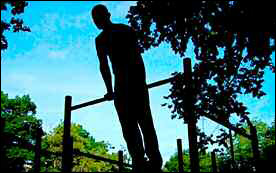
When I say intensity is a factor in your training, I’m talking about what our old friend Tom Hanks was talking about in that quote I mentioned at the start of this chapter. If you aren’t willing to suffer for your passion, do not expect to achieve greatness. The bar doesn’t care who you are or where you come from. It doesn’t care if you are rich or poor. What matters is how much you are willing to endure. So ask yourself...
HOW BAD DO YOU WANT IT?